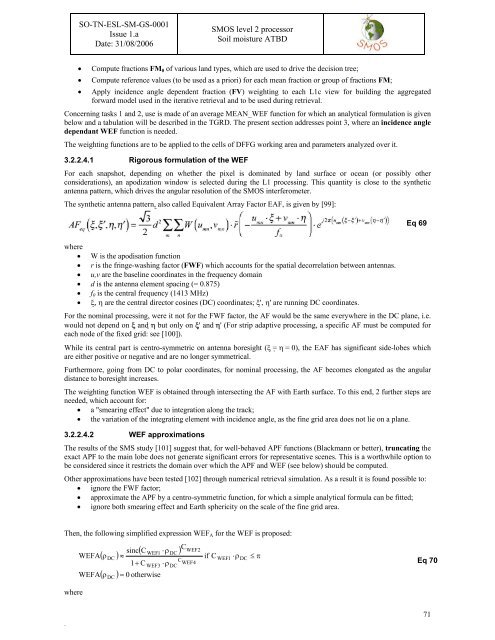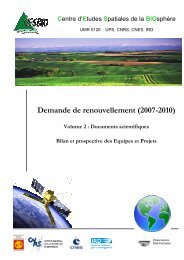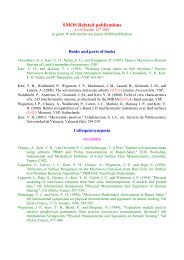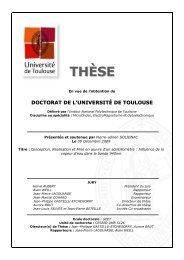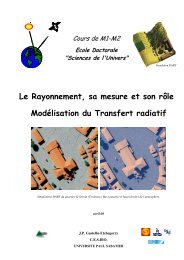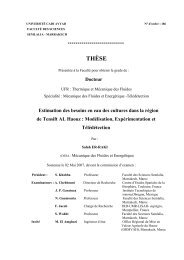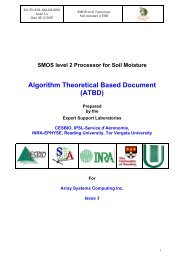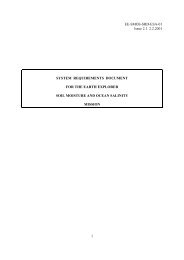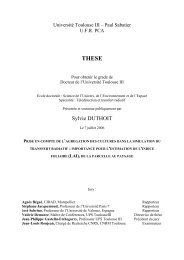Algorithm Theoretical Based Document (ATBD) - CESBIO
Algorithm Theoretical Based Document (ATBD) - CESBIO
Algorithm Theoretical Based Document (ATBD) - CESBIO
You also want an ePaper? Increase the reach of your titles
YUMPU automatically turns print PDFs into web optimized ePapers that Google loves.
SO-TN-ESL-SM-GS-0001<br />
Issue 1.a<br />
Date: 31/08/2006<br />
SMOS level 2 processor<br />
Soil moisture <strong>ATBD</strong><br />
• Compute fractions FM 0 of various land types, which are used to drive the decision tree;<br />
• Compute reference values (to be used as a priori) for each mean fraction or group of fractions FM;<br />
• Apply incidence angle dependent fraction (FV) weighting to each L1c view for building the aggregated<br />
forward model used in the iterative retrieval and to be used during retrieval.<br />
Concerning tasks 1 and 2, use is made of an average MEAN_WEF function for which an analytical formulation is given<br />
below and a tabulation will be described in the TGRD. The present section addresses point 3, where an incidence angle<br />
dependant WEF function is needed.<br />
The weighting functions are to be applied to the cells of DFFG working area and parameters analyzed over it.<br />
3.2.2.4.1 Rigorous formulation of the WEF<br />
For each snapshot, depending on whether the pixel is dominated by land surface or ocean (or possibly other<br />
considerations), an apodization window is selected during the L1 processing. This quantity is close to the synthetic<br />
antenna pattern, which drives the angular resolution of the SMOS interferometer.<br />
The synthetic antenna pattern, also called Equivalent Array Factor EAF, is given by [99]:<br />
Eq 69<br />
where<br />
• W is the apodisation function<br />
• r is the fringe-washing factor (FWF) which accounts for the spatial decorrelation between antennas.<br />
• u,v are the baseline coordinates in the frequency domain<br />
• d is the antenna element spacing (= 0.875)<br />
• f 0 is the central frequency (1413 MHz)<br />
• ξ, η are the central director cosines (DC) coordinates; ξ', η' are running DC coordinates.<br />
For the nominal processing, were it not for the FWF factor, the AF would be the same everywhere in the DC plane, i.e.<br />
would not depend on ξ and η but only on ξ' and η' (For strip adaptive processing, a specific AF must be computed for<br />
each node of the fixed grid: see [100]).<br />
While its central part is centro-symmetric on antenna boresight (ξ = η = 0), the EAF has significant side-lobes which<br />
are either positive or negative and are no longer symmetrical.<br />
Furthermore, going from DC to polar coordinates, for nominal processing, the AF becomes elongated as the angular<br />
distance to boresight increases.<br />
The weighting function WEF is obtained through intersecting the AF with Earth surface. To this end, 2 further steps are<br />
needed, which account for:<br />
• a "smearing effect" due to integration along the track;<br />
• the variation of the integrating element with incidence angle, as the fine grid area does not lie on a plane.<br />
3.2.2.4.2 WEF approximations<br />
The results of the SMS study [101] suggest that, for well-behaved APF functions (Blackmann or better), truncating the<br />
exact APF to the main lobe does not generate significant errors for representative scenes. This is a worthwhile option to<br />
be considered since it restricts the domain over which the APF and WEF (see below) should be computed.<br />
Other approximations have been tested [102] through numerical retrieval simulation. As a result it is found possible to:<br />
• ignore the FWF factor;<br />
• approximate the APF by a centro-symmetric function, for which a simple analytical formula can be fitted;<br />
• ignore both smearing effect and Earth sphericity on the scale of the fine grid area.<br />
Then, the following simplified expression WEF A for the WEF is proposed:<br />
WEFA<br />
WEFA<br />
( ρ )<br />
DC<br />
sinc<br />
≈<br />
1+<br />
C<br />
( C ⋅ρ )<br />
( ρ ) = 0 otherwise<br />
DC<br />
WEF1<br />
WEF3<br />
⋅ρ<br />
C<br />
WEF2<br />
DC<br />
C<br />
WEF4<br />
DC<br />
if C<br />
WEF1<br />
⋅ρ<br />
DC<br />
≤ π<br />
Eq 70<br />
where<br />
.<br />
71


